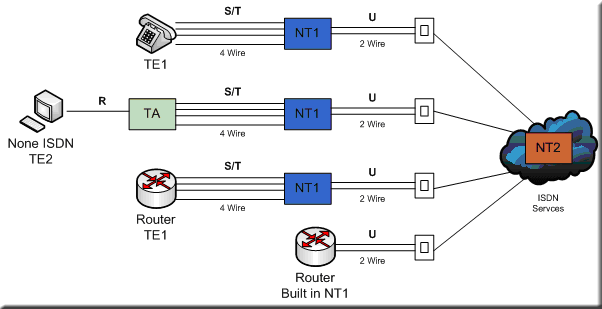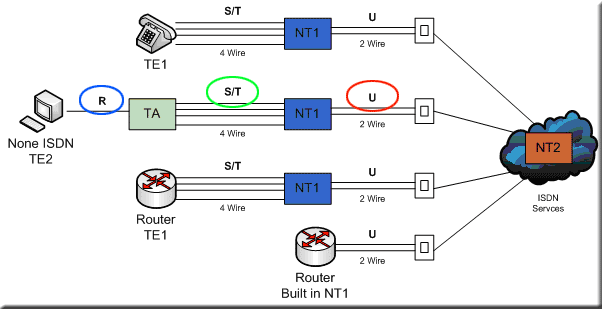ISDN Layers, Protocols & Components
Our previous article was an Introduction To The ISDN Protocol. This article dives a bit deeper by examining ISDN Layers, Protocols & Components.
ISDN uses circuit-switching to establish a physical permanent point-to-point connection from the source to the destination. ISDN has standards defined by the ITU that encompass the OSI bottom three layers of which are Physical, Data Link and Network, see Table 1 below.
At the physical layer the ITU has defined the user network interface standard as I.430 for Basic Rate Access and I.431 for Primary Rate Access; please see the ITU-T I.414 “Overview of Recommendations on Layer 1 for ISDN and B-ISDN customer accesses” document on the ITU's website. ANSI has defined the user network interface standard as T1.601. As already stated above, the physical layer uses the normal telephone cabling as its physical cabling structure.
The ISDN B channels will typically utilise a Point-to-Point protocol such as HDLC (High-Level Data Link Control) or PPP frames at Layer 2 however you can sometimes see other encapsulation such as Frame relay. As you would expect, at layer 3 you typically see IP packets. ISDN operates in Full-Duplex which means that traffic can be received and transmitted at the same time.
The ISDN D channel will utilise different signalling protocols at Layer 3 and Layer 2 of the OSI Model. Typically at Layer 2, LAP-D (Link Access Procedure – D Channel) is the Q.921 signalling used and DSS1 (Digital Subscriber Signalling System No.1) is the Q.931 signalling that is used at Layer 3. It is easy to remember which one is used at which layer by simply remembering that the middle number corresponds to the layer it operates at.
Table 1
|
OSI Layer |
B Channel |
D Channel |
|
3 |
IP |
DSS1 (Q.931) |
|
2 |
HDLC/PPP |
LAP-D (Q.921) |
|
1 |
I.430/I.431 or ANSI T1.601 |
|
Users requiring information on how to configure a Cisco router for ISDN dialup can read our How To Configure ISDN Internet Dialup On A Cisco Router article.
The Different ISDN Components
As part of the ISDN Standards, there are several types devices that are used to connect to the ISDN network which are known as Terminal Equipments (TE) and also Network Termination (NT) equipment. You also have Reference Points which are used to define the connections between the various equipment that is used within the ISDN network.

Terminal Equipment and Network Termination Definitions
• Terminal Equipment Type 1 (TE1) are devices that can plug directly into an ISDN Network and understands the ISDN standards
• Terminal Equipment Type 2 (TE2) are devices that predate the official ISDN standards and require the use of a terminal adapter (TA) to facilitate plugging into the ISDN Network. These can simply be routers that only have a serial interface on them and not an ISDN WIC. The terminal adapter can plug into the serial interface and allow the router to be used to connect to the ISDN network. Another example would be a Personal Computer (PC).
• Network Termination 1 (NT1) is typically a customer's device that is used to implement the physical layer specification into the ISDN Network (or the NT2 device). This is the U Reference point that connects through to the telco. This operates at Layer 1 of the OSI Model.
• Network Termination 2 (NT2) is typically the telco's device (it's very rare to see this at the customers site) that is used to terminate from the customers NT1 device before traffic hits the ISDN network. This operates at Layer 2 & 3 of the OSI Model and is an intelligent device performing the switching.
• Terminal Adapter (TA) is used to convert TE2 device signalling into signalling that is used by the ISDN switch.

Different ISDN Reference Points
• R – This reference point is used to specify the point between the TE2 device and the TA device.
• S – This reference point is used to specify the point between the customers router and the NT2 device.
• T – This reference point is used to specify the point between the NT1 device and the NT2 device S and T reference points can perform the same functions therefore they are sometimes referred to as an S/T reference point. When we are plugging into the S/T reference point location, the function of the NT2 is redundant since it's built in.
• U – This reference point is used to specify the point between the NT1 device and the telco's termination equipment in the ISDN carrier network, apart from in North America where the NT1 function isn't provided by the carrier network.
Cisco Router Options
With Modular Cisco Routers, they come with slots where you can plug in various cards different types of WAN Interface Cards (WIC). Cisco provide 2 different types of WICs for ISDN support. These different cards provide either a ISDN WIC with the S/T reference points which plug into an NT1 device or an ISDN WIC with a U reference point which has the NT1 built into the WIC itself.
Which WIC is required depends on your location and the telco that provides the ISDN circuit. For example, in North America , they use a two-wire connection which is a WIC card with the U reference point, having the NT1 built into it.
More information regarding the configuration of Cisco routers and ISDN confguration can be found in our Basic ISDN Configuration article.
Wi-Fi Key Generator
Follow Firewall.cx
Cisco Password Crack
Decrypt Cisco Type-7 Passwords on the fly!














